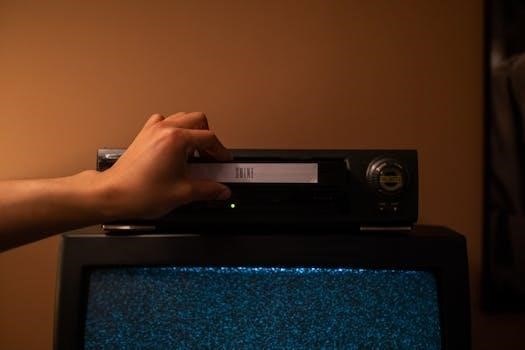Honeywell RTH7600D User Manual⁚ A Comprehensive Guide
This comprehensive guide provides users with essential information about the Honeywell RTH7600D thermostat. It consolidates resources from various online manuals and guides, offering a centralized location to understand the features, programming, and troubleshooting aspects of this user-friendly, 7-day programmable touchscreen thermostat for optimal home climate control.

The Honeywell RTH7600D is a 7-day programmable touchscreen thermostat designed for ease of use and precise climate control. It caters to homeowners seeking a balance between automated scheduling and manual adjustments. This thermostat allows users to customize temperature settings for each day of the week, aligning with their schedules and preferences, thereby optimizing energy consumption and comfort.
The RTH7600D can be configured for both battery-powered and hard-wired installations, offering flexibility in placement. Its adaptive design is compatible with a range of heating and cooling systems, including gas, oil, and electric furnaces, as well as heat pumps. The thermostat features a permanent day and time backup, ensuring consistent operation even during power outages.
This user-friendly device boasts an extra-large, backlit touchscreen display, facilitating easy viewing and adjustments in various lighting conditions. The RTH7600D’s intuitive interface guides users through programming and setting adjustments, ensuring a seamless experience. By understanding its features and functionalities, users can maximize the benefits of the Honeywell RTH7600D, achieving a comfortable and energy-efficient home environment.
Key Features of the RTH7600D
The Honeywell RTH7600D boasts several key features designed for user convenience and energy efficiency. Its prominent feature is the large, backlit touchscreen display, providing clear visibility and easy navigation, even in low-light conditions. The 7-day programmability allows for customized temperature settings for each day of the week, catering to individual schedules and preferences, which results in optimized energy savings.
The thermostat offers both manual and automatic changeover modes, seamlessly transitioning between heating and cooling based on user settings or automatic detection. It supports multiple system types, including heat pumps, gas, oil, and electric furnaces, ensuring broad compatibility. A permanent day and time backup eliminates the need for resetting after power interruptions.
The RTH7600D also includes adaptive intelligent recovery, which learns how long your system takes to reach the desired temperature and adjusts the start time accordingly. Furthermore, it has a filter change reminder, helping maintain optimal system performance. The RTH7600D is designed to provide consistent comfort, energy savings, and ease of use for homeowners.
Understanding the Touchscreen Interface
The Honeywell RTH7600D thermostat features an intuitive touchscreen interface designed for simple operation and clear information display. The large, backlit screen is the central point of interaction, providing easy visibility day or night. The main screen typically displays the current room temperature, the set temperature, the system mode (heat, cool, or off), and the fan setting (auto or on).
Navigating the interface involves tapping the screen to access various menus and settings. Clearly labeled icons and text guide users through programming schedules, setting the clock, and adjusting system settings. Soft keys or virtual buttons are used to increase or decrease temperature settings, change modes, and save configurations. The touchscreen is generally responsive, making adjustments quick and straightforward.
The interface may also include indicators for filter change reminders or low battery warnings, ensuring timely maintenance. Its simple design minimizes complexity, making it accessible to users of all technical skill levels. This focus on simplicity and clarity contributes significantly to the RTH7600D’s user-friendly appeal, allowing for efficient and comfortable home climate control;

Programming the 7-Day Schedule
The Honeywell RTH7600D’s 7-day programmable feature offers users extensive control over their home’s temperature settings throughout the week. This allows for customized heating and cooling schedules to match individual lifestyles and energy-saving preferences. Programming involves setting different temperature points for various time periods within each day.
Typically, the thermostat allows for four time periods per day⁚ Wake, Leave, Return, and Sleep. Each period can be independently programmed with a specific temperature setting. Users can create unique schedules for weekdays and weekends, accommodating different routines. The touchscreen interface guides users through each step, prompting them to set the start time and temperature for each period.
This flexibility enables users to optimize energy consumption by lowering temperatures during periods of absence or sleep, and raising them during times of occupancy. The thermostat remembers the programmed schedule and automatically adjusts the temperature accordingly, ensuring comfort and energy savings. Overrides are also possible for temporary adjustments without altering the permanent schedule. By following the provided instructions, users can easily create a personalized schedule for their needs.
Setting the Clock and Date
Accurate time and date settings are crucial for the Honeywell RTH7600D to function correctly, especially when utilizing its programmable scheduling features. Setting the clock and date ensures that the thermostat adheres to the programmed schedule, automatically adjusting temperatures at the correct times. The process is generally straightforward, guided by the thermostat’s touchscreen interface.
Typically, accessing the clock and date settings involves navigating through the menu options on the touchscreen. The thermostat will then prompt you to set the year, month, day, and time. Use the up and down arrows or touch screen controls to adjust the values. Ensure you select the correct AM or PM setting for the time to avoid scheduling conflicts. Some models may also offer options for displaying the time in 12-hour or 24-hour format.
After setting the clock and date, confirm the changes by pressing the “Done” or “Save” button on the touchscreen. Correctly setting the clock and date will ensure that the programmed schedules will function accurately, thereby ensuring maximum comfort and efficiency. If the thermostat loses power or the batteries are replaced, you may need to repeat this process to maintain accurate timekeeping.
Adjusting Fan Settings

The Honeywell RTH7600D thermostat offers flexible fan control options that go beyond simply turning the fan on or off. Properly configuring the fan settings can significantly impact your home’s comfort and energy efficiency. Understanding these settings allows you to customize air circulation based on your preferences and needs.
Typically, the fan setting options include “Auto” and “On.” In “Auto” mode, the fan operates only when the heating or cooling system is active, circulating air during heating or cooling cycles; This is generally the most energy-efficient setting. In “On” mode, the fan runs continuously, providing constant air circulation throughout your home.
Continuous fan operation can help to even out temperature differences between rooms and improve air quality by continuously filtering the air. However, it also consumes more energy. Some users may prefer running the fan continuously during specific times of the day or night for enhanced comfort.
To adjust the fan settings, navigate to the “Fan” option in the thermostat’s menu. Select either “Auto” or “On” based on your desired operation mode. Once selected, the thermostat will maintain the chosen fan setting until you change it again. Regular adjustment and experimentation can help you determine the ideal fan settings for your home and lifestyle.
System Settings Configuration
Configuring the system settings on your Honeywell RTH7600D is crucial for ensuring it operates correctly with your specific heating and cooling system. These settings define the type of system you have (e.g., heat pump, conventional furnace) and how the thermostat controls it.
Accessing the system setup menu allows you to specify parameters such as the heating and cooling system type, staging options, and other advanced configurations. Incorrect system settings can lead to inefficient operation, discomfort, or even damage to your HVAC equipment. Consulting your HVAC system documentation is advisable before making any changes.
The system setup typically involves identifying whether you have a heat pump or a conventional heating/cooling system. For heat pumps, additional settings might include reversing valve configuration and auxiliary heat control. For conventional systems, you may need to specify the fuel type (gas, oil, electric) and the number of heating/cooling stages.
Carefully review each setting option and select the appropriate value based on your system’s characteristics. If you are unsure about any particular setting, it’s best to consult with a qualified HVAC technician. Proper system configuration ensures the thermostat communicates effectively with your heating and cooling equipment, optimizing performance and energy savings.
Manual and Auto Changeover Explained
The Honeywell RTH7600D thermostat offers both manual and automatic changeover modes, providing flexibility in how your heating and cooling system operates. Understanding the difference between these modes is essential for optimizing comfort and energy efficiency.
In manual changeover mode, you explicitly select whether the thermostat controls the heating or cooling system. You must manually switch between “Heat,” “Cool,” or “Off” as needed, depending on the weather and your desired indoor temperature. This mode gives you direct control but requires active management.
Automatic changeover mode allows the thermostat to automatically switch between heating and cooling based on your setpoints and the current room temperature. You set separate heating and cooling setpoints, and the thermostat will engage the appropriate system to maintain your desired comfort level. This mode is convenient and ideal for climates with fluctuating temperatures.
When using auto changeover, it’s crucial to set a reasonable temperature range between your heating and cooling setpoints to prevent excessive system cycling. For instance, a difference of 3-5 degrees Fahrenheit is generally recommended. This setting can be configured within the system settings menu of the thermostat, ensuring seamless transitions between heating and cooling as needed.
Troubleshooting Common Issues

The Honeywell RTH7600D thermostat is generally reliable, but users may occasionally encounter issues. A blank display is a common problem, often resolved by replacing the AA batteries. Ensure the batteries are fresh and properly installed.
If the thermostat isn’t reading the temperature correctly or following the programmed schedule, double-check the schedule settings and ensure they are correctly configured for each day of the week. Verify that the system is not set to “Hold,” which overrides the programmed schedule.
Another common issue is the inability to use the auto-select feature for heating and cooling. This problem can arise from incorrect system type settings. Access the system setup menu and confirm that the system type (e.g., heat pump, gas furnace) is correctly configured. Mismatched wiring can also cause operational issues; ensure all wires are securely connected to the correct terminals based on your system’s wiring diagram.
If problems persist, consult the user manual or contact Honeywell customer support for further assistance. Resetting the thermostat to factory defaults may resolve some issues, but note that this will erase your programmed settings.
Resetting the Thermostat
Resetting your Honeywell RTH7600D thermostat can resolve various operational issues by restoring it to its original factory settings. This process clears any custom programming, including schedules and preferences.
To reset the thermostat, first, detach it from the wall plate. Locate the reset button, typically found on the back or side of the thermostat. Use a small object, like a paperclip, to gently press and hold the reset button for a few seconds.
After releasing the reset button, reattach the thermostat to the wall plate. The thermostat should power on and display the initial setup screen. You will then need to reconfigure the system settings, including the date, time, and programming schedule.
Consult your user manual for specific instructions on your particular model. Note that resetting the thermostat will erase all personalized settings. If a reset doesn’t resolve the issue, further troubleshooting or professional assistance may be required. Also, before resetting, ensure you have noted down any specific configurations you wish to reinstate afterwards.
Customer Support and Warranty Information
Honeywell provides comprehensive customer support for the RTH7600D thermostat, ensuring users can easily access assistance when needed. For troubleshooting, FAQs, and detailed product information, visit the Honeywell Home website. You can also find helpful resources like video tutorials and user forums.
If you require direct assistance, Honeywell’s customer care team can be reached via phone at 1-800-468-1502. Have your thermostat model number (RTH7600D) and purchase date readily available when contacting support.
The Honeywell RTH7600D typically comes with a limited warranty, protecting against manufacturing defects. The warranty period usually lasts for one year from the date of purchase. Be sure to retain your proof of purchase as it is required for warranty claims. The warranty covers repairs or replacements of defective parts, but it does not cover damages caused by misuse, improper installation, or normal wear and tear. Consult the official warranty document included with your thermostat for detailed terms and conditions.
